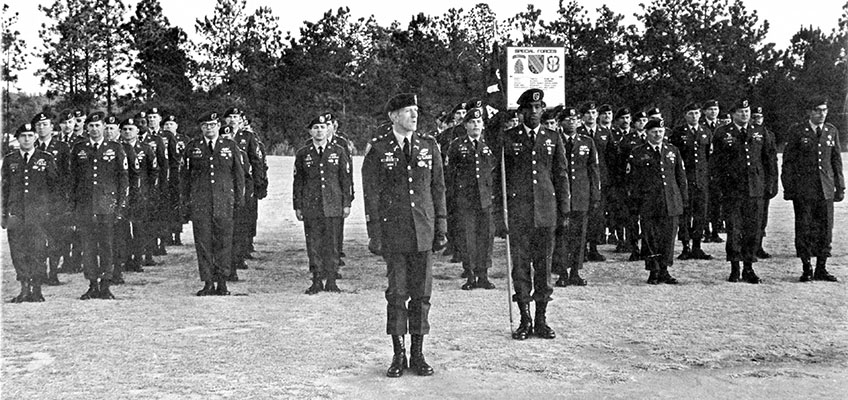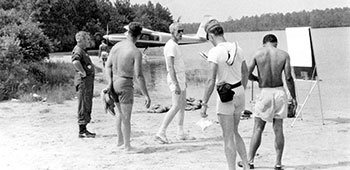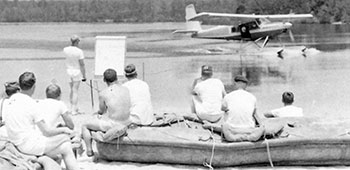SECTIONS
SIDEBAR
TAKEAWAYS
- They were not trained or prepared to conduct fixed-wing water LZ operations. It took all day to do an orientation and practice a few basic skills.
- It was no simple task to climb aboard a Super Courier and get into the crew compartment on the water. The U-10A rarely carried a crewman to assist.
- The SF soldiers in shorts, t-shirts, and tennis shoes had to paddle like crazy to keep the RB-10 alongside the idling airplane whose spinning propeller pulled it forward at 6-7 mph. And, weapons, radios, and rucksacks were not in the rubber boats.
- This relatively unpracticed WWII concept was not worth the time and resources necessary to develop and sustain as a capability. It was an impractical ‘novelty’ insertion/recovery system rarely used by the OSS. Its fancifulness was hyped by the motion picture industry.
- SF boat operation capabilities in 1974 were no better than those of WWII. Yet, British WWII Commando kayak training would be promulgated by SWCS through the 1980s.
- It would require a tremendous amount of time, dedicated manpower, and air coordination to conduct practical work with amphibians or seaplanes to develop viable TTPs to set up, operate, and dismantle a fixed-wing water LZ in daylight let alone at night.
- SF Leaders must question the viability and practicality of SF doctrine, missions, and concepts promulgated in FMs. Updates tend to be ‘cut and paste’ with little analysis or common sense applied. SF capabilities must be constantly and objectively validated to maintain relevancy. Ask the question: Is it outdated or irrelevant?
- While motorized inflatable boats would speed the clearing of water LZs, facilitate staying up with an ‘idling’ aircraft, and keep LZ marker boats in position, the engine noise would reduce stealth and attract enemy agents and/or forces.
- Sophisticated air defenses—air and mobile ground—and rotary-wing aircraft relegated single and twin-engine fixed-wing airplane tactical and operational missions to history. Transport and resupply were not categorized as operational in Vietnam, let alone today.
DOWNLOAD
Just after daybreak in late spring 1974, a brown and white U-10A Super Courier floatplane approached Mott Lake on Fort Bragg, NC. The Department of Army Civilian (DAC) instructor pilot, Mr. Jay S. Sparks, Sr. flying the U-10A, established radio contact with the 3rd Battalion, 5th Special Forces Group (SFG) soldiers aboard their 10-man inflatable rubber assault boats (RB-10s) awaiting training. The pilot needed four key pieces of information before landing: observed helicopter activity in the area; assurance that the water landing zone (LZ) was free of underwater obstructions (down to 30 inches); verification that the lake surface was clear of floating logs, debris, or moored craft; and the wind direction and velocity. After comparing wind data with the direction and height of water ripples, Mr. Sparks deftly landed the light short takeoff/landing (STOL) airplane inside the 500 foot ‘safe touchdown area,’ reversed direction, and taxied to the Mott Lake ‘beach.’1 Now, the SF soldiers had to actualize tactics, techniques, and procedures (TTPs) not addressed in Field Manual (FM) 31-20: SF Operational Techniques.2
The purpose of this article is to show how innovative, realistic training was accomplished despite severely constrained resources after the Vietnam War. The situation will be explained at the macro level before descending to the tactical or micro level. First came the SFG deactivations and then came the Army reductions-in-force (RIFs).
At the MACRO Level
The 1st, 3rd, and 6th SFGs had been deactivated. Several Army RIFs decimated ranks of reserve lieutenants, captains, and majors who dominated the SF officer corps, reduced Operational Detachment Alpha (ODA) manning, and cut company and battalion staffs to ‘bare bones.’ The RIFs destroyed SF operational readiness as effectively as volleys of grapeshot. Pentagon service staffs declared common Vietnam acronyms, COIN (counterinsurgency) and UW (unconventional warfare), to be ‘bad words.’3 SF companies (ODCs or C Teams) led by lieutenant colonels (LTCs) had been changed to battalions to merit O5 (pay grade) command credit. ODBs became companies led by majors who focused on rebuilding SF credibility and ODA proficiency by training to standard on individual and collective tasks.4 Fortunately, Air Force and Army aircrews had to maintain proficiency with ground forces.
The active, Reserve, and National Guard had annual support requirements. The appeal of SF exercises was that they were interesting, challenging, and encompassed a wide variety of missions. ‘Becoming smart’ on the needs and standing operating procedures (SOPs) of each service’s aviation fostered the coordination of ‘win-win’ training activities. By taking advantage of the Army aviation units at Fort Bragg and Air Force Joint Airborne and Air Transport (JAAT) training airlift enabled 3/5th SFG to conduct quality training in the worst of times.5 It is hard to appreciate ‘value added’ without a short summary of events that contributed to this constrained resource environment, as shown in the sidebar “A Most Tumultuous Time In Modern U.S. History, 1960-1975.”
Since young soldiers reflect American society and culture, the events cited in the adjacent sidebar impacted heavily on the Army of the 1970s. Presidential decrees expanded U.S. military fighting role in South Vietnam, not a Congressional declaration of war. Stemming the spread of Communism worldwide was bipartisan national policy. By the early 1970s, ‘Middle America’ was tired of the heavy human cost of fighting the nation’s longest war to date (more than 10 years). With Vietnam as the top priority, U.S. Army, Europe (USAREUR) became a ‘caretaker command.’ Drug and racial issues that ‘plagued’ the military in Vietnam in the late 1960s led to serious disciplinary problems by the time U.S. withdrawals had begun. In Europe, Army unit leaders adopted ‘peaceful coexistence’ attitudes to maintain some semblance of order. When Army Military Personnel Center (MILPERCEN) began flooding Europe in 1972 with Regular Army officers and career non-commissioned officers (NCOs) to rebuild operational readiness and restore order and discipline, drug and alcohol problems and racial tensions exploded.7






